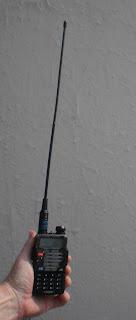The Baofeng UV-5RA is a dual band UHF/VHF hand held radio from China. It has an output of 4 watts but with an optional high gain antenna I have no problem making contact on any of the local repeaters in my area. The radio can be programmed from the keypad but it is much easier to program it from either the Baofeng software that comes with the programming cable or CHIRP software. RT Systems also sells a cable and programming software for this radio.
The radio is well supported by a Yahoo Group: Baofeng_uv5r
The radio has a large LCD display and it is very easy to read. You can also set the display to three different colors, orange, blue and purple.
The radio can be set for single watch or dual watch, which allows you to monitor up to 2 different frequencies at a time. The display can show text (name), frequency or channel number. It does not have a VFO button to switch you to the frequency display but one way around that is to set the A band to NAME option and set the B band to FREQUENCY. If you need to know what frequency you are on simply look at the A band that you are talking on for the channel number. Then hit the A/B button, dial it in on the B band and read the frequency. That is much faster than figuring it out using the menu function.
The radio can be set for single watch or dual watch, which allows you to monitor up to 2 different frequencies at a time. The display can show text (name), frequency or channel number. It does not have a VFO button to switch you to the frequency display but one way around that is to set the A band to NAME option and set the B band to FREQUENCY. If you need to know what frequency you are on simply look at the A band that you are talking on for the channel number. Then hit the A/B button, dial it in on the B band and read the frequency. That is much faster than figuring it out using the menu function.
The radio can also be used as a marine band VHF radio. The CHIRP software has a an auto setting in the programming options. If you are a boater you can move the VHF Marine frequencies to the corresponding channel numbers where you would normally find them on a Marine VHF radio. That way if you need to get to Marine VHF 16 you just enter 016 on the keypad and you are there.
The radio comes with SMA-J flexible antenna, 7.4 volt 1800mAh Li-ion battery, belt clip, wrist strap, wall wart AC adapter and drop-in charging tray. Average chart time is 4 hours.
This radio FCC Part 90 acceptable, dual watch, and can support up to 128 different programmed channels. I have been using this radio for about 6 months and it has proven to be a great tool for my various needs.
There have been some chip set upgrades to this unit which have improved ease of use, voice menu and performance. Turning on the power while pressing the 3 key will display which chip set the radio has in it. Version 293 and above are preferred by most users.
I suggest the UV-5RA to be purchased with the following accessories:
I suggest the UV-5RA to be purchased with the following accessories:
* High Gain Antenna
* External Speaker Mike
* Car lighter adapter
* Programming Cable and software
For my local Long Beach Hams I can sell and configure this radio for your needs, load software and drivers on your lap top, test it, and include a CD Rom of resources for $100. I will also be happy to run you through the operation of the radio as well as the software.
How to order:
Email me at KI6DZV@GMAIL.COM for more information.Specifications of UV-5RA found on the Internet:
VHF/ UHF DUAL-BAND TWO WAY RADIO
Frequency Range: 136-174 / 400-480MHz
Dual-Band Display, Dual Freq. Display, Dual-Standby
Output Power: 4 /1Watts
128 Channels
50 CTCSS and 104 CDCSS
Built-in VOX Function
1750Hz Brust Tone
FM Radio (65.0MHz-108.0MHz)
LED Flashlight
Large LCD Display
Hight /Low RF Power Switchable
25KHz/12.5KHz Switchable
Emergency Alert
Low Battery Alert
Battery Saver
Time-out Timer
Keypad Lock
Monitor Channel
Channel Step: 2.5/5/6.25/10/12.5/25KHz
Roger Set
■ Dual band, dual display, dual standby
■ A/B band independent operation
■ 128 groups channels storage
■ Shortcut menu operation mode
■ VFO & Memory channels scan
■ Emergency Alarm
■ Tri-color background light selectable
■ 0~9 grades VOX selectable
■ PTT & ANI ID
■ FM radio and 25 stations storage
■ Voice companding
■ CTCSS/DCS coder & tone searching
■ PC programmable
■ Wide/Narrow Band(25kHz/12.5kHz)
■ Transmitter time-out timer(TOT)
■ High/Low TX power selectable
■ Busy channel lock-out(BCLO)
Specifications:
General
Frequency Range 65-108MHz(FM Receive only)
136-174MHZ and 400-480HZ (TX/RX)
Channel No. 128
Frequency Stability ±2.5ppm
Antenna High gain DualBand Antenna
Antenna SMA - Female
Antenna Impedance 50Ω
Operating Voltage DC 7.4V
Mode of operation Simple or semi-duplex
Dimension(W x H x D)100 x 52 x 32 mm
Weight 250g (including battery, antenna)
Transmitter
Output power 4W / 1W (Max 5W)
Modulation Mode 16kΦF3E / 11kΦF3E
Maximum deviation <5kHz(Wide) / <2.5kHz(Narrow)
Spurious Radiation <7μW
Adjacent Ch. power ≤-65dB(Wide) / ≤-60dB(Narrow)
Pre-emphasis characteristics 6dB
Current ≤1.6A(5W)
CTCSS/DCS deviation 0.5±0.1kHz(Wide) / 0.3±0.1kHz(Narrow)
Intermediation sensitivity 8-12mv
Intermediation distortion <10%
Earpiece / mic type Kenwood Plug type






